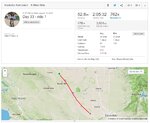So, the Specialized marketing guy says that the Brose mid-drive is much more "efficient" than the hub drives they use now (he is a marketing guy, so what else would he say?). Leaving aside things like weight distribution for off-road riding, riding feel, and so on and focusing on the efficiency of the new mid-drives - What does "efficient" mean? How can one motor of a certain power be more "efficient" than another? How can a motor with internal mechanics like gearing be more "efficient" than one without?
I am skeptical of the efficiency claim.
I am skeptical of the efficiency claim.
